Contents
Guide
WATERCOLOR WITH ME
IN THE OCEAN
DANA FOX



The author and publisher have provided this e-book to you for your personal use only. You may not make this e-book publicly available in any way.
Copyright infringement is against the law. If you believe the copy of this e-book you are reading infringes on the authors copyright, please notify the publisher at: http://us.macmillanusa.com/piracy.
Watercolor with Me: In The Ocean is the second book in the Watercolor with Me series. This time around, were diving deep into the ocean to discover a world full of colorful, unique creatures with step-by-step painting instructions to make them come to life.
Throughout this series of fifty watercolor projects, youll gain the confidence and skill to create beautiful art, whether youre a total beginner or simply looking to expand your creativity. Youll be presented with a faint sketch of each subject on the right-hand page and details to complete each piece on the leftalong with tips, supplies, color palettes, and tools required. The projects are broken up into three main sections: Youll learn about these techniques before you start painting so you can confidently put that brush to paper. Lets get started!
All illustrations in this book use the Winsor & Newton Cotman line of watercolor paints. Below are the colors used in the projects for your color-matching reference (white is also used but not shown):
 Supplies youll likely need:
Supplies youll likely need: Watercolor paint Clean water Mixing palette Round watercolor brushes (sizes 212) Fine detail brush Black permanent-ink pen White ink pen Paper towels
DANAS FAVORITES
For my favorite and most recommended watercolor supplies, please visit my Amazon shop at: http://amazon.com/shop/wonderforest. , youll see three colored circles. , youll see three colored circles.
Each of these circles uses a method of wet-on-wet that is used in the projects in this book. 1) The first circle was completely wet beforehand, using clean water, then two colors were dropped in on both the top and bottom areas. 2) The second circle was not wet beforehand, but rather filled with a single color, Ultramarine. While the paint was still wet, Permanent Rose was dropped into the area. As a result, this pretty lilac shade was created! 3) The third circle demonstrates a lifting technique that we will use in some projects. The paper was wet and a color was dropped in.
Then a dry brush was used to lift some of that color out of the center portion. Try each of these techniques in the blank circles shown below the colored ones! Next, practice wet-on-wet drops by wetting the blank coral graphic with clean water and dropping in various concentrated colors. Try not to add too much additional water to the color mixes beforehand or the paper will become a big puddle! If you need to, you can lift off any blobs using the dry-brush technique. Once youve got these methods down, move on to complete your first project! 
This sea turtle is so fun to paint due to all of the colorful shapes. Dont let it intimidate youits really easy! Youll be working on one shape at a time and using the wet-on-wet technique to create effortless, gorgeous color blends.
Color Chart

Supplies
Round brush (size 6 works well) 4 colors of paint Fine detail brush Black ink pen

1.
Starting with the shell, fill one of the shapes with water with your brush, leaving a little dry space around the edges. The paper should be glossy, not soaked. 2. Drop Burnt Sienna onto the wet area with your round brush and carefully drag the paint along the dry edges that were avoided. This will ensure crisp lines. 3.
Drop small amounts of Raw Umber directly on top of the same wet area to create a textured effect. 4. Repeat steps 1 through 3 for each shell shape, being careful not to let one area blend into the next by leaving a thin white line of paper between each. 5. When the shell is dry, wet the turtles remaining body with clean water. 6.
Mix a little bit of Yellow Ochre and Raw Umber with White and apply it to the wet body area. Concentrate more Raw Umber in the shadow areas, such as under the shell. 7. When that layer is dry, fill in the spots on the fins and head with varying shades of Raw Umber. Add details like the mouth, wrinkles, and outlines with a fine detail brush. 
Just like the tail of a humpback whale, each watercolor painting is unique! Thats the beauty of this piece.

Just like the tail of a humpback whale, each watercolor painting is unique! Thats the beauty of this piece.
The monochrome palette and subtle, galaxy-like wet mixes make for a truly stunning finished product.
Color Chart

Supplies
Round brush (size 6 or 8 works well) 2 colors of paint Fine detail brush White ink pen

1. Begin by wetting the entire top half of the whale using your round brush. This includes his face, body, fin, tail, and front flipper. 2. 3. 3.
While the area is still damp, brush Indigo along the top edge of the body, fin, and face, allowing it to blend into the lighter shade underneath. 4. Add another swipe of Indigo along the bottom damp edge and the edges of the flipper. Repeat steps 1 through 3 for the back flipper. 5. Once everything is dry to the touch, apply another light wash of Cerulean Blue to the underbelly of the whale.
While this is still wet, drop in a little Indigo under the chin for dimension. 6. Allow your painting to dry. Using your fine detail brush, create lines on the underside of the whale using Indigo. Also define the mouth and eyeball with the same paint and brush. 7.
Finish it off by using a white ink pen for highlights under the mouth line and wrinkles on the body. 


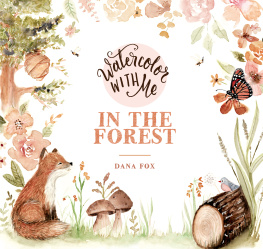
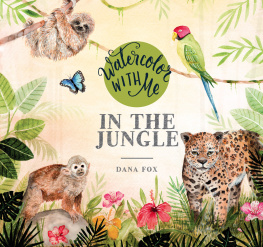

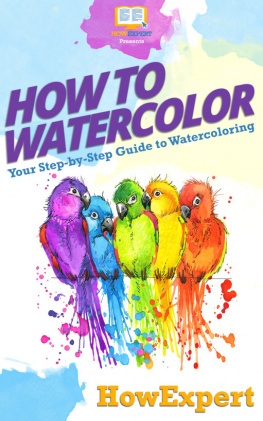
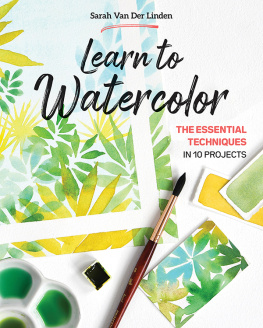
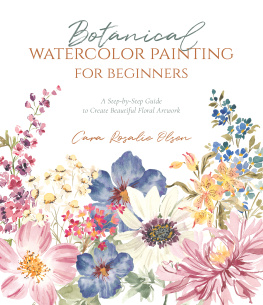

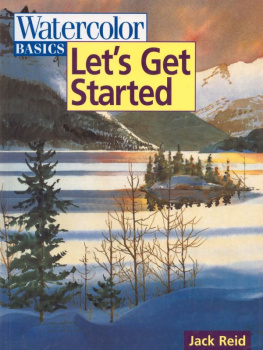



 The author and publisher have provided this e-book to you for your personal use only. You may not make this e-book publicly available in any way. Copyright infringement is against the law. If you believe the copy of this e-book you are reading infringes on the authors copyright, please notify the publisher at: http://us.macmillanusa.com/piracy. Watercolor with Me: In The Ocean is the second book in the Watercolor with Me series. This time around, were diving deep into the ocean to discover a world full of colorful, unique creatures with step-by-step painting instructions to make them come to life.
The author and publisher have provided this e-book to you for your personal use only. You may not make this e-book publicly available in any way. Copyright infringement is against the law. If you believe the copy of this e-book you are reading infringes on the authors copyright, please notify the publisher at: http://us.macmillanusa.com/piracy. Watercolor with Me: In The Ocean is the second book in the Watercolor with Me series. This time around, were diving deep into the ocean to discover a world full of colorful, unique creatures with step-by-step painting instructions to make them come to life.  Supplies youll likely need: Watercolor paint Clean water Mixing palette Round watercolor brushes (sizes 212) Fine detail brush Black permanent-ink pen White ink pen Paper towels
Supplies youll likely need: Watercolor paint Clean water Mixing palette Round watercolor brushes (sizes 212) Fine detail brush Black permanent-ink pen White ink pen Paper towels 

 1.
1. 

 1. Begin by wetting the entire top half of the whale using your round brush. This includes his face, body, fin, tail, and front flipper. 2. 3. 3.
1. Begin by wetting the entire top half of the whale using your round brush. This includes his face, body, fin, tail, and front flipper. 2. 3. 3. 